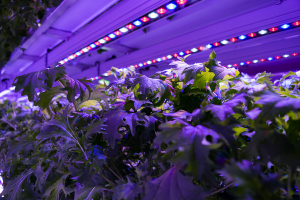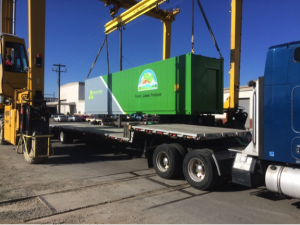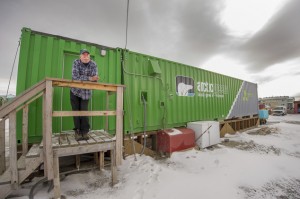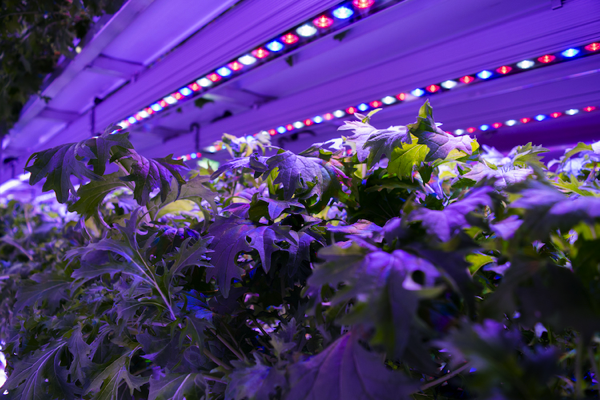The vast Arctic territory is rich in resources including minerals, hydrocarbons, and wildlife. However, high latitudinal regions receive little sunlight for several months each year, which severely limits the region’s ability to grow fresh produce. Many Arctic urban centers rely on long, complex supply chains to receive shipments of fresh fruits and vegetables from their southerly neighbors.
Alaska imports about 95% of its fresh produce, moving about $2 billion per year of grocery spending out-of-state. Produce destined for the Arctic has to be picked early and ripened in-transit to minimize rot during the long journey from farm to table. Such practices affect the quality of produce polar consumers can buy and drive up prices. Arctic residents often pay exorbitant prices for items as simple as a head of lettuce.

Source: Vertical Harvest Hydroponics
These problems have spurred interest in alternative farming methods in the Arctic, such as indoor farming using hydroponics and artificial lighting systems, sometimes called vertical farming (Figure 1).
In recent years, the use of vertical farming has grown in many urban areas, where land is scarce and people have become more aware of the environmental impact of long-supply chains. Urban indoor farms, or ‘plant factories with artificial light’ (PFAL) are expected to play a large role in agriculture during the coming decades, garnering interest from countries around the world. Recently a team of Japanese and American researchers published a comprehensive 400-page volume on the benefits and limitations of indoor farms in different climatic and economic environments.
The ability of PFALs to produce quality produce has been proven in a low cost and resource effective manner. For example, low-heat light emitting diode (LED) fixtures have been around since the 1980s, but recent studies have shown that advances in this technology have enhanced their brightness and energy-efficiency to the point where they are viable in commercial crop agriculture. As these global investments in urban farming continue, the resulting technological innovations could have a revolutionary effect on how Arctic communities source their fresh produce.
The unique environmental and economic conditions of the Arctic make it an attractive region to develop PFALs. Prices for imported fresh produce are high, while environmental conditions for local farming are poor. Moreover, communities in the Arctic are usually isolated, and their inhabitants tend to welcome innovations that increase self-subsistence and decrease reliance on imports.

Source: Vertical Harvest Hydroponics
Several start-ups have begun to fill this niche in the North American Arctic, among them Vertical Harvest Hydroponics. This company, founded in 2011 and based in Anchorage, Alaska, has designed and developed a “Containerized Growing System” in repurposed shipping containers using cutting edge technology (Figure 2). These containerized systems cost about $110,000 each to build and deploy. They are designed to withstand the harsh Arctic conditions, and are mobile—giving Arctic communities the ability to grow produce anywhere with potable water and power. Each unit can produce about 23,000 to 39,000 heads of lettuce per year.
Another Alaskan company, Alaska Natural Organics,has retrofitted an old dairy in Anchorage to house an indoor farm, which can produce up to 20,000 plants per month. The potential for expansion seems strong, as these companies are still young and operate on a relatively small scale compared to the mega-PFALs running in Japan, which can produce up to 10,000 plants a day (Figure 3).

Source: National Geographic Magazine
Vertical farming in the Arctic has gained recent media attention due to its success. In 2016 several mainstream media outlets, including the New York Times, local CBS news stations, and farming magazines featured articles on indoor farming in the Arctic. Unfortunately, there is a lack of academic literature analyzing the practicality of PFAL systems and vertical farming in an Arctic-specific context, a subject which should be explored given the massive potential applicability of this technology in the region.
Interest in biological preservation and the development of agriculture in the Arctic is nothing new. In Svalbard, the Global Seed Vault is safeguarding a repository of all global plant seeds in an attempt to secure the genetic diversity of flora on this planet in case of a devastating disaster. The Norwegian government, which runs and administers the storehouse, has also taken steps toward increasing the study of sustainable agriculture in the region through the year 2021 with the BIONAER program. In Kirovsk, Russia, the Polar-Alpine Botanical Garden has been active since 1931, as a nursery, biological research institute, and tourist attraction. Interest in these new techniques is growing, with representatives of the city of Murmansk, Russia citing a planned project to convert abandoned industrial buildings into hydroponic farms during an interview. The Russian Arctic has many relatively isolated industrial and post-industrial urban centers, where the development of efficient PFAL systems could usher in a new era of sustainable agriculture. In all of these Arctic regions, the interest in using PFALs to increase the local quality of life is high, however there has been a lack of project feasibility studies and academic literature which could validate increased policy support for PFAL and urban indoor farming methods.

Source: Will Anderson via AP
Given the interest in indoor-farming across the circumpolar region, PFAL systems could play an important role in the future life of Arctic communities. The success of the Alaskan start-ups shows the potential for the organic growth of the industry. These systems have the potential to benefit Arctic communities by cutting out expensive and unreliable supply-chains and increasing self-reliance. Indoor farming greatly improves the quality of life for Arctic residents by giving them a realistic path towards regular access to fresh high quality produce. Additionally, localized food production and research in PFAL technology has the added benefit of creating jobs and opportunities for innovation in the region. Nevertheless, the PFAL industry faces significant challenges, including high initial investment costs, which could hamper growth in the coming decades. Hopefully, this hurdle will not be insurmountable.

Interesting. This method would also be productive in the high Andes, for example, where fresh veggies are rare.